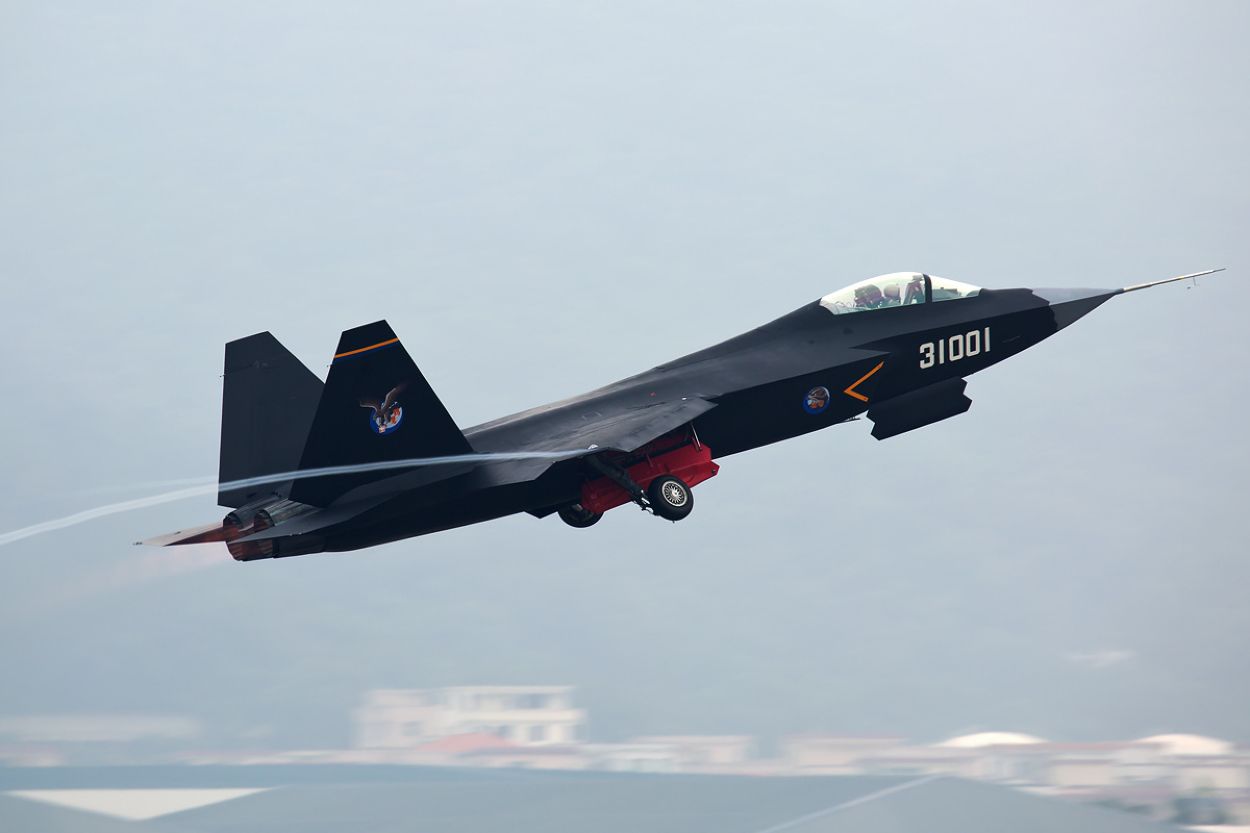Pakistan could acquire China’s other stealth fighter, the Shenyang FC-31 (or J-31), according to its air force and army chiefs. The news comes just as the fighter is also being readied to operate from China’s Fujian aircraft carrier and become Beijing’s second carrier-borne strike fighter after the J-15.
The future transfer of the FC-31 can also be seen as China’s attempt to transfer another roughly comparable stealth jet to the J-20 since the export and commercialization of the latter are prohibited. The FC-31, on the other hand, was also developed with commercial intent and first flew publicly in the 2014 air show in China.
The next best thing to the J-20, it potentially has a significant amount of fifth-generation technologies like advanced electronics, avionics, radars, mission computers, fire control systems, and internal weapons bays, making it a capable air dominance fighter.
PAF’s Top Boss Reveals Plans For J-31
Pakistan Air Force (PAF) chief Air Chief Marshal Zaheer Ahmed Babar Sidhu confirmed the service’s acquisition of the FC-31 stealth fighter. At an “induction and operationalization” ceremony, Sidhu said the “foundation for acquiring the J-31 stealth fighter has already been laid, which is all set to become part of the PAF’s fleet in the near future.” Sidhu was also accompanied by Pakistan Army chief General Asim Munir at the ceremony.
The platforms formally inducted include the J-10C fighters, air mobility aircraft like the C-130H, Airbus A319, Boeing 737, Piper M-600, BKA-350i, new radar systems, unmanned aerial vehicle (UAV) like the Bayraktar Akinci, TB-2, Shahpar-2, swarm drones and “long-range vectors,” which possibly include surface-to-air missiles (SAM) with greater reach.
J-31 History
The J-31 is broadly similar in its mission profile to the J-20 and the US F-22A Raptor. These are not multirole fighters but pure stealth-enabled air superiority jets. The J-20, for instance, carries its missile load internally and has been assessed to use its stealth, electronic warfare, and jamming systems to slip past enemy fighter screens and take out targets, possibly vulnerable support aircraft like air-to-air refueling tankers or airborne early warning (AEW) aircraft.
The FC-31, on the contrary, was originally meant as a technology demonstrator and an export product only. It failed to attract any international customers, and interest from the People’s Liberation Army Air Force (PLAAF) was also lukewarm initially, which eventually did not place any orders.
There were also reports of it being turned down by the PLA Navy and the People’s Liberation Army Air Force (PLAAF), but it was revived for carrier operations after growing tensions with the US in the Western Pacific.
The J-20, too, was ruled out from carrier operations – given it would require a complete redesign of the airframe to have foldable wings to operate from a carrier. Both China’s stealth aircraft will have been envisaged to operate together over the western Pacific.
Capabilities & Use
The J-31 can carry four PL-15 medium-range air-to-air missiles in the internal weapons bay and two short-range PL-10 missiles for dogfights on external hardpoints. Indeed, it has been indicated that the FC-31/J-31 can also carry weapons on its external hardpoints, but this will compromise stealth and will depend on the tactical situation at the time.

When it enters service with the PLAN, possibly aligned with the operationalization of the Fujian carrier, the J-31 might undertake the basic aerial protection roles for the fleet and integral support for the J-15s from enemy fighters, while the latter conducts the complex anti-ship and ground strike missions.
This is given its smaller and lighter profile. The J-15 (a Chinese derivative of the Russian Su-33) is the larger, heavier jet primarily assessed as the PLAN’s primary air superiority/multirole mainstay.
The J-15 and the J-31 are expected to operate together, particularly the latter being speculated from the Fujian. This is indicated by mockups of the J-31 on the Fujian in photos emerging on social media.
What Might Pakistan Get
Pictures from July 2022 showed the J-31’s first clear image on the ground with the maintenance crew surfacing. This had the serial number 35003 and a gray tactical paint job.
The front-landing gear also appeared to have a catapult hook to prepare it to launch from the Type 004 Fujian’s electro-magnetic launch system (EMALS).
This section aims to establish that what Pakistan might get is the non-navalized version, with the basic configuration, just as it is being rapidly readied for being inducted into the PLAN.
Therefore, Pakistan might sign the contract for the J-31 either just around the time the first batches of the J-31s begin rolling out of SAC factories. Or, it could be a few years after that when the first squadron in the PLAN has been operationalized, post a limited series production batch.
- The author can be reached at satamp@gmail.com
- Follow EurAsian Times on Google News